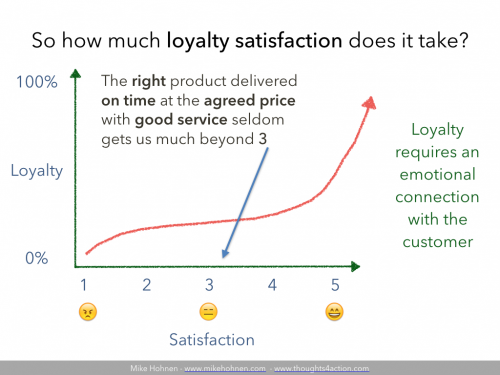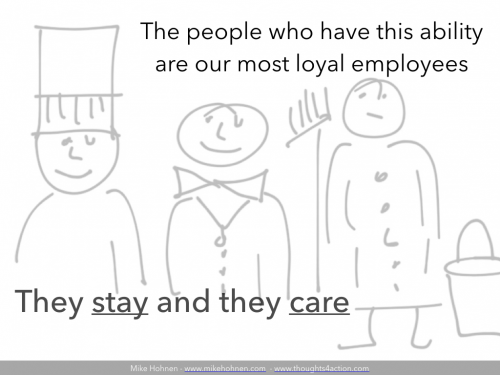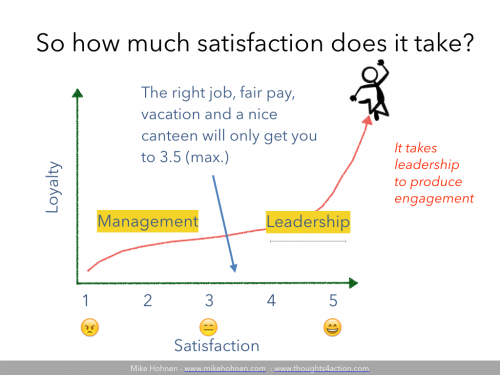Helping organisations implement the Service Profit Chain is what I do and have done for the past 17 years. So over time, I notice that certain patterns repeat themselves.
The basic premise of the Service Profit Chain is that the key to profit and growth is to cultivate customer loyalty. Customer loyalty occurs when guests are very satisfied. So invariably the question is: How satisfied do our customers need to be before the loyalty effect starts kicking in?
It varies a bit depending on a number of factors but for now, let’s just use the ultra simple way of looking at it.

The research is pretty clear.
Basic satisfaction does not create loyalty. What we are really looking for is customer enthusiasm. The challenge, however, is that when we get it right. When we deliver exactly the right ‘product’ at the right price on time and in the quality that was agreed, we only get to 3 or 3.5 in satisfaction. And it does not get us anywhere near generating any form of loyalty.
So doing it right is just the first step. To that we need to add the emotional component. When our frontline staff makes an emotional connection with the guest, loyalty is generated.
Now, we cannot put a clause in the employment contract with our frontline staff that they must develop emotional connections. It does not work that way. We and our staff create emotional connections, go the extra mile, display empathy, etc. when we feel like it.
So who on our team can do this?

Our most loyal and engaged employees do this. They do it because they feel like it, not because they are told to do it.
And fundamentally, they do it because they enjoy their job. Loyalty and engagement is a consequence of high levels of satisfaction. The obvious question then is how satisfied do they need to be in order for loyalty and engagement to occur?

Again the challenge is that when we provide a good job, at fair wages, breaks, vacation and a nice canteen. Then we only achieve a level of satisfaction of 3 or 3.5 at the best. Well organised and structured jobs provide the baseline. If we want more, we need to provide what is essential to an emotional connection. They need to ‘feel’ enthusiastic about their job, the people they work with, and the company they work for.
Simple to describe, not so easy to do.
The issue in a nut shell, seen from my point of view having now worked with hundreds of managers in service organisations, is that their main focus is on the management part of their job. This is what gets measured especially short term and this is more tangible in the form of check lists, planning, controlling etc.
It is also what stands out very clearly when it is not done. Not doing the management part of your job quickly gets you into trouble – so we do that first.
When it comes to the leadership component, two obstacles are common.
There is a time issue and there is lack of understanding about what leadership means in practical day to day things they must do. They often understand the need but many of them don’t actually know what it means in practical behaviour terms. What must I actually do?
So when time is scarce and you are unsure what it is you should be doing, the result is simple: It does not get done.
And the end result is what you can read loud and clear in the yearly Gallup engagement surveys, that year after year show us that around 60+ % of the workforce are not particularly engaged in their job. What a waste.
For the next few weeks I have therefore decided I would like to focus on the leadership component. To try and demystify it and translate what may seem fluffy to some people into practical steps that can relatively easily be integrated into your busy day.
If you would like to brush up on the principles of the Service Profit Chain, we have a free e-learning module that you can take it HERE.
______________________________________________________
This post is one of a series where we are exploring the notion of leadership and how this is different from management. Our starting point is the Service Profit Chain and the understating that the management part of our job will only take us so far. If we really want to create an organisation that is capable of delivering outstanding customer experiences, we need to develop an organisation that delivers outstanding employee experiences – and that requires leadership.
[…] If you did not read last week’s post, you might want to read that first – you will find it here. […]